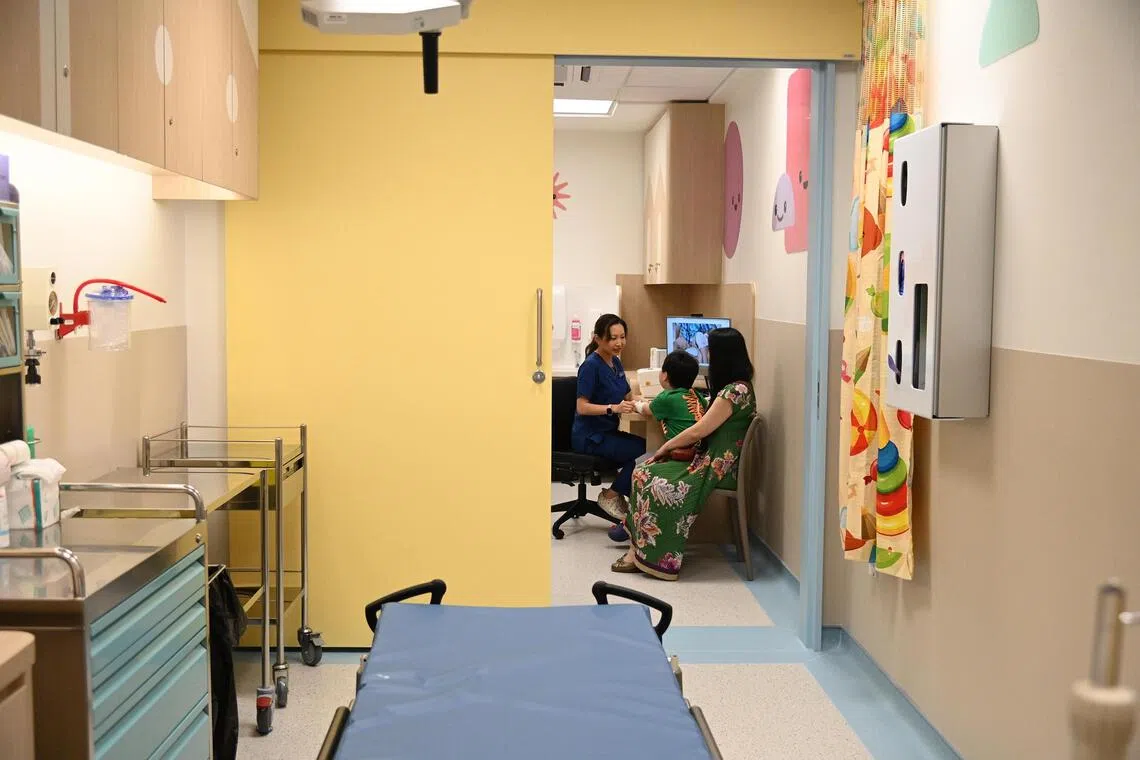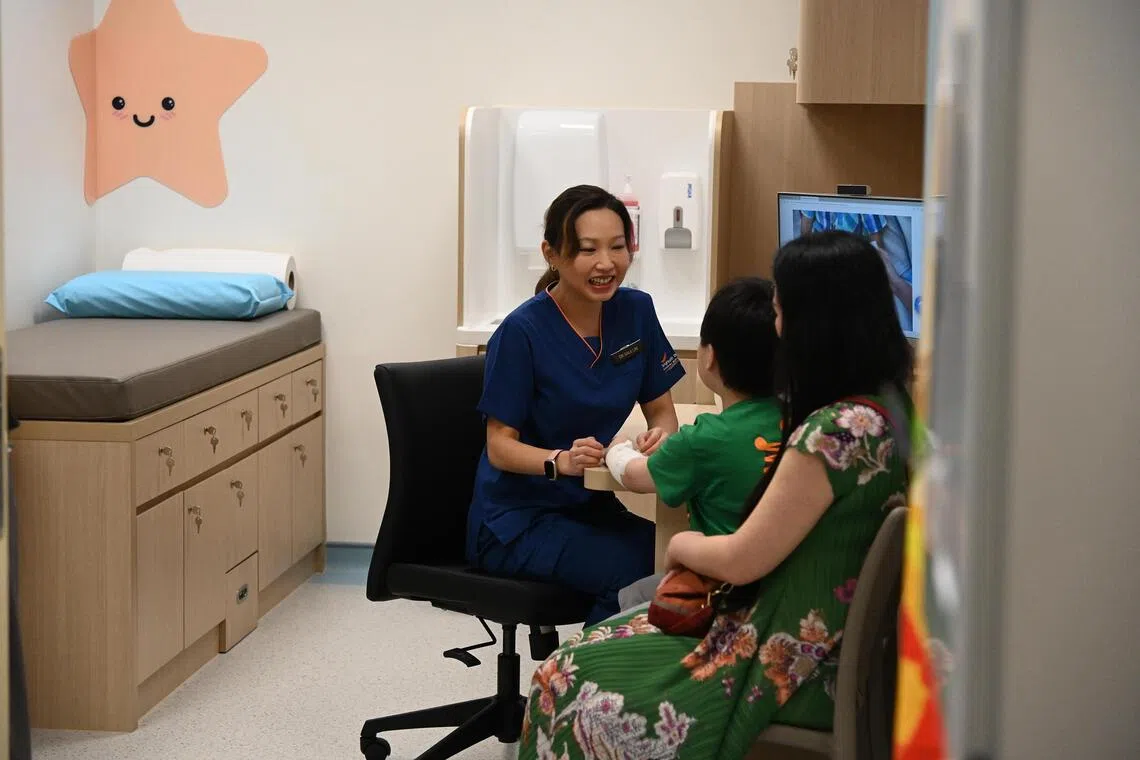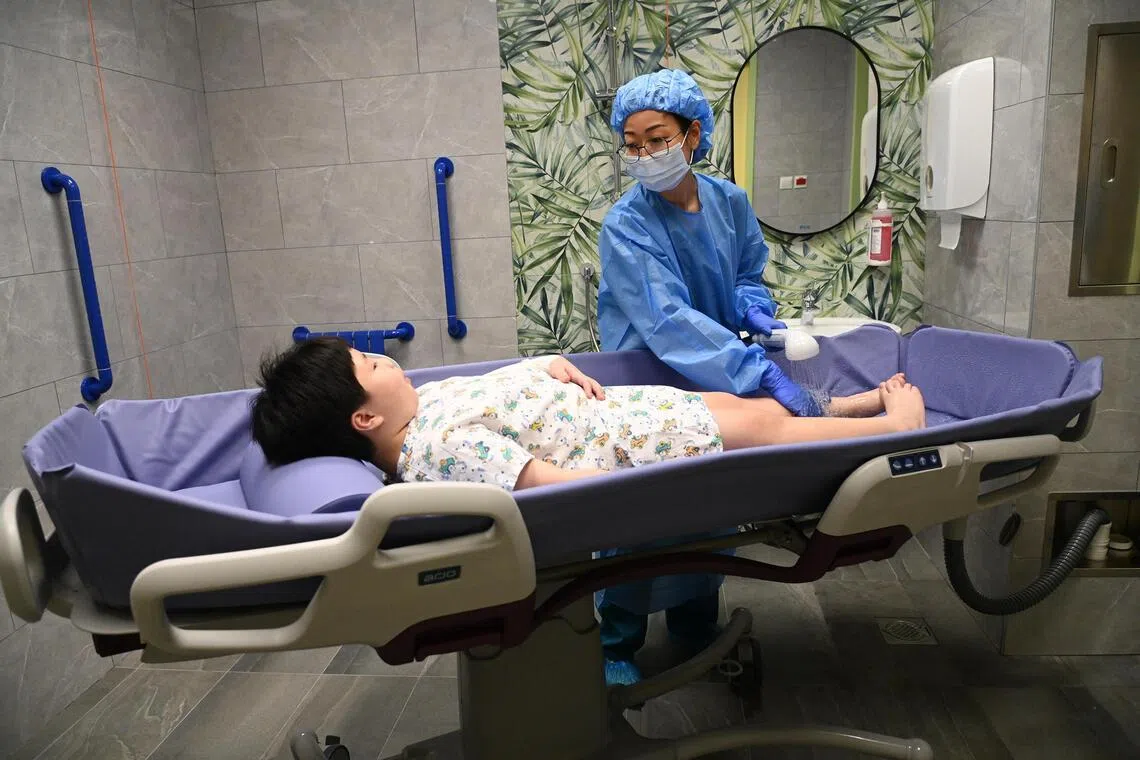Singapore’s first specialised burn centre for kids at KKH provides improved treatment
Sign up now: Get ST's newsletters delivered to your inbox

The doctor's consultation room is directly connected with the treatment room so that parents can be present when treatment is carried out.
PHOTO: KKH
Follow topic:
- Singapore's first specialised burn centre for children opened at KK Women's and Children's Hospital, offering integrated care.
- KKH treats up to 400 new cases of children with burn injuries yearly, with scalds being the top cause of injuries, at 71%.
- The centre uses innovative methods like WMCS, which speeds up healing and reduces pain. Special shower beds enables treatment under anaesthesia.
AI generated
SINGAPORE – Singapore’s first specialised burn centre for children officially opened on Oct 23 at KK Women’s and Children’s Hospital (KKH), offering fast, integrated treatment that reduces stress and pain for patients.
The centre is staffed by a multidisciplinary team of plastic surgeons, nurses and allied health professionals, providing full care ranging from acute treatment to rehabilitation.
Located on the second floor of the hospital’s Children’s Tower, the centre is part of KKH’s ongoing efforts to enhance and expand its services and infrastructure so that it can adapt to future needs.
The centre has increased capacity, innovative features and streamlined processes to shorten treatment times while strengthening infection control measures.
For instance, its consultation rooms are directly connected to treatment rooms, ensuring seamless care from assessment to treatment, and enhancing infection control and emergency response.
A specialised shower bed enables single-location treatment for wound cleaning and drying under general anaesthesia, eliminating the need to move young burn patients between rooms and minimising infection risks.
Previously, children with burns had to endure the entire process while awake and in pain.
Dr Gale Lim, who heads the Department of Plastic, Reconstructive and Aesthetic Surgery at KKH, said this treatment process significantly reduces stress, fear and anxiety for both the children and their parents.
Every year, KKH treats up to 400 new cases of children with burn injuries, and this figure has remained consistent over the last five years.
Infants and toddlers, aged two years and below, are the most vulnerable, accounting for half of the cases. Children aged five to 10 make up 17 per cent of the cases.
In 2024, the top three causes of burn injuries in children were scalds from hot water and soups (71 per cent); contact burns from irons, hair curlers, pot covers and oven doors (19 per cent); and friction burns from treadmills and road traffic accidents (5 per cent).
One such patient was seven-year-old Julius Lim. While attempting to pour hot water from a vacuum flask, he accidentally spilled the 90 deg C water on his chest, causing his skin to blister and peel.
At the emergency department, medical staff did wound debridement – the process of removing dead, damaged or infected tissue from a wound to promote healing – and applied a silicone dressing on his wounds. Julius was then sent to the burn centre for a follow-up.
His wound healed within one-and-a-half weeks because of the quick intervention.
Dr Lim said the first hour after a child sustains a burn is the most critical as “fast and effective treatment can mean the difference between life and death”.
This prevents potential complications such as shock from the excessive loss of body fluids, wound infections, deepening of burns, and lung complications in the case of smoke inhalation.
“It (also) profoundly shapes his long-term recovery and development,” Dr Lim added.

Dr Gale Lim said the first hour after a child sustains a burn is the most critical as “fast and effective treatment can mean the difference between life and death”.
PHOTO: KKH
This was the lesson learnt by the medical team following a fire at Tomato Cooking School in River Valley Road in April
Dr Lim said children are not small adults, and they experience pain more intensely.
“They have underdeveloped coping skills and often have great difficulty understanding what is happening to them... The pain of a burn injury can be excruciating for the child and deeply distressing for caregivers,” she added.
KKH introduced wireless microcurrent stimulation therapy (WMCS) in 2021 to enhance burn healing in children.
A pain-free treatment, it delivers an electric current to the wound surface to encourage recovery and suppress inflammatory reactions.
In a world-first WMCS trial, conducted between July 2016 and September 2021, the hospital treated 80 children with superficial partial thickness burns.

Senior staff nurse Carene Ling using a specialised shower bed to clean and dry a patient with burns. He is under general anaesthesia to manage the pain.
Copyright: KKH
It found that the treatment sped up burn healing from an average of over eight days using conventional dressings, to almost six days using WMCS.
Burn deepening rates also fell from 20.8 per cent with conventional dressings, to about 6 per cent using WMCS, with minimal side effects.
“By prioritising comfort and emotional well-being throughout their care, we help children respond more positively to procedures to hasten healing. That’s why early, specialised care is so crucial,” Dr Lim said.
KKH is the first hospital outside the United States and Canada to receive recognition for paediatric pain management from global non-profit organisation ChildKind International in 2022.
Julius’ mother, Madam Keira Chea, 41, an executive director in the banking industry, said: “Julius was worried and fearful at first, but with the nurses explaining what they were doing and how it can help him get better faster, he seemed more relaxed and willing to have the procedures done.”


